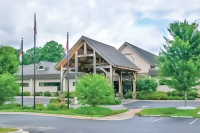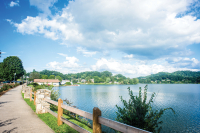A race against time
While it’s hard to imagine as one gazes at the vast wilderness of the Great Smoky Mountains National Park, more than two-thirds of the lush forests were clear-cut by timber companies in a couple of short decades preceding the park’s creation.
Ridge after ridge, the slash operations of the timber giants denuded the mountains, gobbling up massive forests at lightening speed during the 1910s and 1920s.
“Looking at these wonderful mountains with this timber, they couldn’t wait to cut it down,” Duane Oliver said of the timber barons arrival. Oliver grew up in the Swain County portion of the park prior to its creation and recalls their lasting influence.
Large mill towns were born virtually overnight to support the operations. Oliver remembers the hustle and bustle of Proctor, one of the larger logging towns. The once rural area was suddenly home to a movie theater, tennis court and their first resident doctor.
While the lumber camps attracted hundreds of workers from outside the region, the logging operations and their railroads gave rise to a cash-based economy on a scale previously unknown by local people. For many, the desire for a steady paycheck often outweighed their internal conflict over the destruction they were witnessing.
“People were glad to get jobs that paid money,” said Luke Hyde, 69, of Bryson City, whose grandfather on both sides worked as loggers. “Most people in the mountains were subsistence farmers and considered it lucky to get work where they made money. Even when I was a lad people conducted business by barter. Money was in short supply so people would swap things.”
Related Items
The timber boom wouldn’t last forever, of course. The barons would soon move on, leaving the mountains denuded and thrusting the local people back into poverty — only this time, without their prized forests. The stripped hillsides would no longer be fertile hunting grounds and the creeks once teeming with trout would be decimated by clear-cutting.
In this sense, the park movement entered the stage at just the right time. When talk of a national park in the Smokies began percolating in the early 1920s, local people could see logging would soon go bust. It made it far easier to latch on to the idea of a tourism economy hung on the neck of a national park, even though it was still a foreign concept.
“You’ve got to understand how poor people were. They were looking for anything that might help,” said Claude Douthit, born in 1928 amidst the movement to create the park.
While the lumber companies had brought a short-lived boom, mountain people could see that the jobs would dry up when the lumber companies disappeared. But unlike logging, tourism would be here to stay, park proponents pledged.
“If we use this a magnet to draw tourists, it will be something that will produce forever,” Pierce recounted of their argument. “If we make this a park it will be like the goose laying the golden egg.”
Wresting it away
When the states of North Carolina and Tennessee began buying land for the park in 1927, there were eight large lumber companies operating in what would become the park — among them the well-known Ritter, Norwood, Kitchen, Champion, Suncrest, Whitmer-Parson and Crestmont — as well as a myriad of smaller ones.
Some timber companies had already logged most of the timber and saw a chance to unload the wasteland left behind.
“The lumber companies had come in here and dry-cleaned the whole darn thing,” said Douthit. “They came in and bought the land for nothing, cut the lumber then sold their land to the park.”
The timber companies didn’t exactly go quietly, however. They fought hard for a national forest instead of national park. With a national forest, they could return every few decades to recut what had grown back, but not so with a national park.
Many timber companies balked at the price initially offered for their holdings — in North Carolina it was $10 to $20 an acre — and went to court to get more. The crux of the argument was they needed to be paid not just for the land, but the value of the still standing timber.
While lumber companies had certainly burned through vast tracts of timber already, they weren’t ready to quit while there was still logging to be done, according to Dan Pierce, a UNC-Asheville professor who is an expert on Smokies history.
“Most of these companies still had plenty that had not been logged,” Pierce said.
The timber companies had the deep pockets necessary to fight the land takings in court — and in the meantime continued logging. One of the more storied cases involved Champion, a large timber company with a paper mill in nearby Canton. To demonstrate the cost of logs needed to feed its mill, Champion faked a shipment of specialty spruce from Sweden at a vastly inflated price to flout as evidence of the great cost they would incur through the loss of their timber land.
A jury awarded Champion a generous amount, due in part to the economic tour de force the timber companies were in local communities (although the IRS later discovered a juror in the case got a $15,000 bribe from Champion).
The government appealed Champion’s award — indeed it seemed whichever side lost would have done the same — and the two appeared locked in a dead-end battle.
“Champion recognized this could drag on a long time, and meanwhile they have all these assets tied up,” Pierce said. “Once the Depression hits, Champion realizes ‘If we get this cash, we can do a lot with this.’” So they settled out of court for $2 million — about $20 an acre.
The lengthy court battles with the timber companies pushed the tab for the park’s creation higher than anticipated. Park proponents estimated the raw cost of buying land would be $10 million, and it was.
“What they didn’t figure on were the legal fees and the cost of appraisers to estimate the value of the timber,” Pierce said, “which ran close to $1 million.”
The timber company owners went to their graves claiming they had lost money on the sale of their holdings to the park.
But Margaret Brown, a history professor at Brevard College and the author of a leading book on the park’s creation, The Wild East, thinks otherwise.
“I think they made out like bandits. They made money on the land three ways. They bought it very cheaply, they got everything off it they could, and then got reasonably good prices from the United States government once it was sold,” Brown said. “I think they did just fine for themselves.”
An unlikely ally
Ironically, if it weren’t for the massive logging operations, it is likely the Great Smoky Mountains National Park would not be here. The timber companies made critical contributions to the park movement.
For starters, they played a valuable role sorting out the muddled nature of property deeds in the high mountains, Brown said. When the timber companies arrived in the early 1900s, land ownership often dated back to the first land grants. The boundaries of the original claim, let alone how it had been parceled up through the generations, was fraught with confusion.
When timber companies made their first forays into the Smokies, they often relied on a land speculator to buy up a hodge-podge of tracts and resell them as a block, often landing in court to sort out who held clear title. Unfortunately, a few landowners were out-lawyered and in effect had their land stolen. By the time the park came along two to three decades later, much of the land had been consolidated as large tracts owned by a handful of timber barons.
The timber era also had pushed the region into a cash economy, and it seemed there was no going back to a subsistence lifestyle, Brown said. Addicted to commerce, even if on a rural scale, it made people more willing to accept the idea of tourism as a replacement.
But most importantly, the nation and locals alike saw intrinsic value in the Smokies. Before the timber barons, people couldn’t imagine losing the mountains, so they had no concept of saving them.
“It raised the consciousness of people that it was something they wanted to protect,” Brown said.









